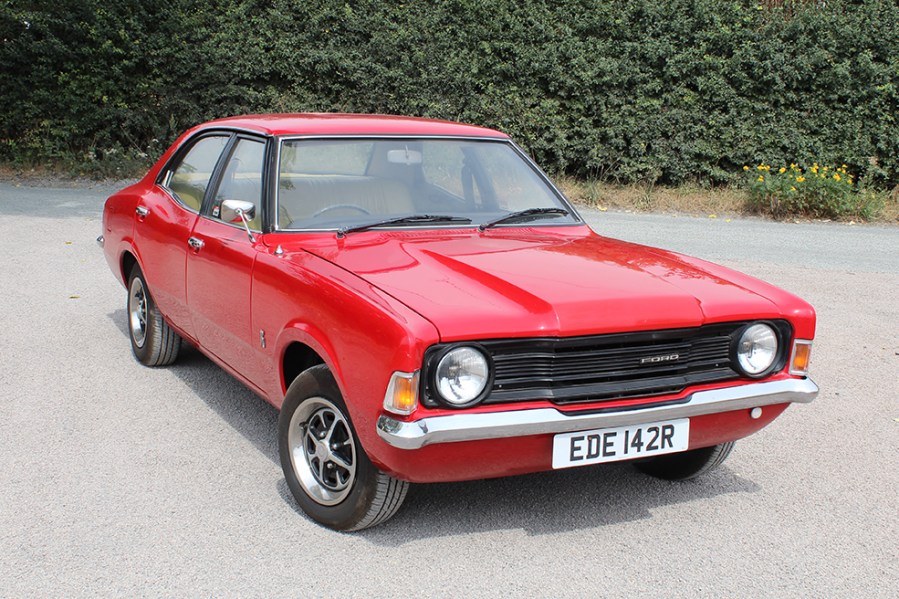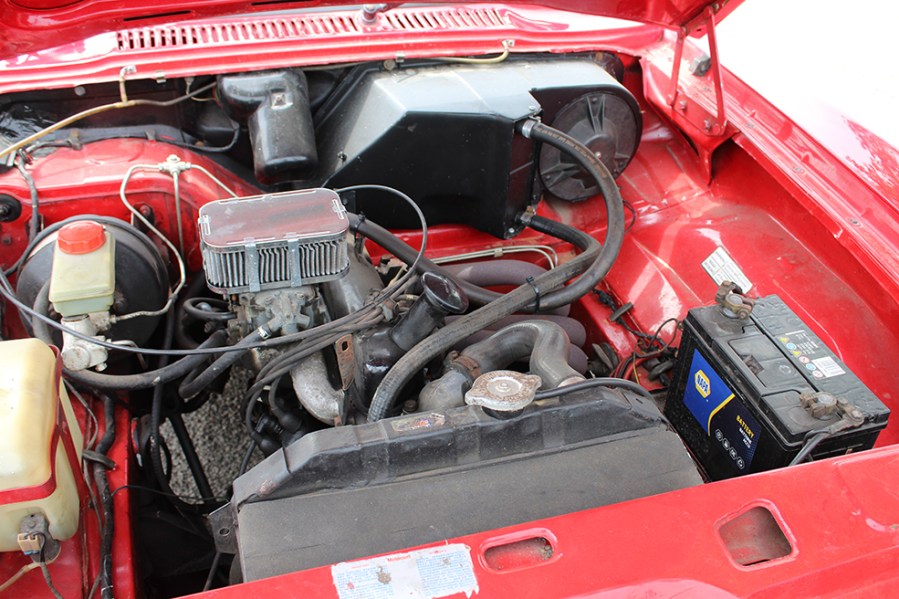The Morris Marina could never match the sales domination of the Ford Cortina in the 1970s. How do these family favourites stack up today?
Images: Jeff Ruggles
Sometimes figures don’t tell the whole story, and that was certainly the case for BMC 1100/1300 range. The ADO16 may have reigned supreme at the top of Britain sales charts for eight years between 1963 and 1971, but while it was the darling of the private motorist, the lucrative fleet market shunned its front-wheel drive and complex Hydrolastic suspension in favour of the simplicity and perceived reliability of stylish but far more straightforward offerings from Ford. And as BMC merged into in British Motor Holdings and subsequently the British Leyland Motor Corporation in 1968, an answer to the relentless march of the Blue Oval was needed – fast.
That answer was the Morris Marina – a car that would become Cowley’s Cortina. The 1100/1300 was a big seller but was always questionable from a profit point of view, so this time the focus was on taking a leaf from Ford’s book – a simple rear-wheel drive layout using components shared with other models, clothed in a highly stylised body. This was not a car to break ground, but to bang on trend for the market of time. Heck, it was even styled by the same man as the Mk2 Cortina, Roy Haynes, who had been pinched from Ford in late 1967. Incidentally, it was the Mk2 that had managed to stop knock the ADO16 off its perch that year.
The idea was to give customers more metal for their money, but by time the car had been put on sale, the Ford template had changed. Its new Mk3 Cortina was bigger still, well costed and very stylish. If their contrasting reputations are to be believed, the Cortina has any back-to-comparisons sewn up – you’ve only got to look at the comments on our Classics World Cortina v Marina YouTube video to witness that. But after 50 years of jokes and falling pianos, are things really as clear cut as the lower half of the internet would have you believe?
The accepted version of events is that during the formation of BLMC, the incoming management was horrified to discover that there were no new models in the pipeline for imminent release. In short order an edict was issued that the corporation should have a Ford Escort challenger ready to unveil at the Earls Court show in 1970. Unsurprisingly, development short cuts were welcome wherever possible.

Morris Marina
Developed under the codename ADO28, the Morris Marina was to unashamedly be a bit of parts-bin special. Engines would be sourced from other models, the gearbox and rear axle came were Triumph items, the front suspension was the Morris Minor’s torsion bar set-up with lever arm dampers, and a pair of leaf springs held up the rear.
By contrast, the body was all new, albeit somewhat familiar. Impressively, Roy Haynes’ Mk2 Cortina-aping design made it through to production little changed from the early concepts, having beat off competition from prestigious international names Michelotti and Pininfarina. Awkwardly though, Haynes would leave BL in 1969, which meant that Harris Mann was promoted to Chief Stylist and tasked with completing the design details for production.
By then though, the Morris Marina had been thrown another curve ball by market researchers. The greatest growth in the volume market was not in the Escort size but in the class above, the so-called 1.2 to 2.0-litre segment. The brief was hurriedly revised to move the Marina upmarket but fortunately Haynes’ original design had provided a suitably capacious engine bay for larger power units. Initially plans surrounded the new E-Series OHC motor, but cost considerations meant the car went to market with the 1275cc A-Series and 1.8-litre B-Series as its engine options.
Proven components should have meant the Marina worked ‘out of the box’, but a rushed development period, restricted budgets and crucial decisions made too late left the car wanting in some areas. Both Motor and Autocar testers were so shocked by the significant understeer of the 1.8-litre models both on the press launch and in their first road tests that the staffers put aside their bitter commercial rivalry and each title sent representatives to discuss the matter with Harry Webster.

It was grudgingly admitted that the problem was recognised and that the road test cars had been pre-production examples, lacking a revised suspension mounting which had been developed to increase negative camber during cornering. The editors were assured that all production 1800 models and later all 1300 cars would use the revised set-up and a publicity disaster was avoided when both magazines were gentle in their initial appraisals.
Despite what urban myth would have you believe, early sales were good, aided by problems with the early Mk3 Cortina and a range that, unlike the Ford, included a two-door coupe. An estate version of the Marina was announced in October 1972, and by 1973 the Marina even found itself in the number two sales spot. Production edged encouragingly close to the ambitious 5000-per-week target, although as ever the industrial relations issues rife at BL rather hampered things.
The Marina was originally conceived as a stop-gap which was only intended to remain in production until 1976-1977, and if left at that, would surely have been deemed a success. However, under a cash-strapped and now part-nationalised BL, it was left to fend for itself in the marketplace with little additional investment. And with the demise of the so-called SD2, a proper replacement wouldn’t arrive until 1983/84 as the Maestro/Montego.
It wasn’t entirely ignored though, and in 1975 a Series 2 car was released, featuring new model designations and more suspension tweaks. There was also a minor facelift inside and out, bringing with it a curious interior restyle which saw the radio facing away from the driver.

In 1978, the car finally received a more modern engine option when the B-Series was replaced by the overhead cam O-Series. Offered in an unusual 1.7-litre format it offered 78bhp and improved refinement, although the Moggy’s now costly lever-arm dampers remained underneath.
Amazingly, the Morris Marina would soldier on until 1980 when it was replaced by the Ital, which even then was only a mild facelift of the original and was itself another stop-gap. The lever arm dampers would finally disappear in 1982, but in 1984 it was finally laid to rest. By the time Marina-badged production had ended, a total of 1,135,343 had been produced, but can the driving experience match up to the commercial success?
Early signs are promising. Our steed here is an early 1.8 Super from the launch year of 1971, borrowed from Pioneer Autos and resplendent in very attractive Teal Blue with Limeflower interior. Jumping inside, the dashboard feels immediately familiar to me as a Mini 1275 GT owner, sharing the same dials, and the same goes for the perforated vinyl trim. It looks workmanlike now, but would’ve looked pleasingly contemporary at the time.
And first impressions are pleasant when behind the wheel, too. The rack and pinion steering is precise, and the ride is comfortable enough to belie its humble underpinnings. No, it’s not the last word in handling finesse, and yes, there’s some body roll as you’d expect, but the urban rumours suggesting an understeering monster are very much wide of the mark. I’m sure understeer could be provoked if pushing hard enough, but the reality is that here is a most inoffensive car which is very easy to drive. Besides, later cars gained modified suspension with anti-roll bars front and rear, which largely eradicated any issues.

Being an 1800 Super with the 1.8-litre, single carb B-Series motor producing 82bhp, it pulls rather well too. It’s not as quick as the range-topping 95bhp 1800TC, which in coupe form could outperform the MGB, but if feels well suited to the car despite having its roots in the mid-50s.
Given the short development time and meagre budget BL had, the Marina drives better than it should. Indeed, that’s something I find with many of these early and mid-‘70s BL products, which are nowhere near as bad as folklore would have you believe. By the late ‘70s, it was outclassed by newcomers like the Mk1 Cavalier, but that’s not the Marina’s fault. Compared to the more humdrum models in the Mk2 Cortina range and the Escort it was originally conceived to challenge, it stands up well. The snag was, it was put up against the new Mk3 Cortina…
Ford Cortina Mk3
When Ford launched its Mk3 Cortina in 1970, it was massive gamble. The outgoing Mk2 model was still popular, so its maker could be forgiven for simply tinkering with the formula and reaping the rewards. However, such was the change in direction that many in the product planning department felt it needed a new name.
Things looked similar on paper, with two and four door saloons, plus an estate. But rather than anchor its top models to the 1.5-litre class as before, Ford opted to make the Mk3 significantly larger and top the range off with a 2-litre model, thus edging the car into a different market segment and swallowing up the Corsair range in the process. The Mk3 wasn’t any longer than the old Mk2 in saloon form, but the wheelbase was up by three inches and the width by a similar amount. That also served to make the wheelbase 5.5 inches longer than the Marina, and 2.5 inches wider.

The Mk3 marked the convergence of the German Taunus and British Cortina platforms for the first time, but the UK car differed by employing a Detroit-inspired ‘Coke-bottle’ design that was bang on trend at the time and in complete contrast to the boxy Mk2. Inside, the initial sloping dash design looked like it had been lifted out of a Mustang.
In addition, Ford showed its marketing nous by offering a bewildering array of different models to suit a wide range of pockets. Ford was no stranger to badge hierarchies, but with the Mk3 particularly popular as a company car, the new model really pushed the value of a few extra letters into the mainstream. You could have the base model, the L, XL, GT and GXL, with the latter pair equipped with quad headlights and Rostyle wheels to further increase their car park kudos.
Mechanically though, the Mk3 wasn’t quite as pioneering as its looks indicated. The MacPherson strut front suspension was replaced with more conventional double A-arm suspension set-up biased towards comfort, while a familiar live rear axle remained. The range also retained the 1.3-litre OHV Kent Crossflow engines for the base and L models, but there were new 1.6 and 2-litre overhead cam Pinto units too, which included the novelty of a belt-driven camshaft. It wasn’t quite that simple though, because the 1.6-litre Kent hung around for the lesser models, while the home market GT and GXL got the OHC version.
The Mk3 had huge sales potential, but its early impact was blighted by a questionable ride, handling and refinement, as well production difficulties caused by a 10-week strike. Ford reacted quickly though; during 1971 it improved the suspension issues by tweaking the spring and damper rates, and in 1972 the Cortina would storm to the top of the sales charts, where it would remain for four consecutive years.

A substantial facelift in late 1973 further enhanced things, with the universal adoption of the Pinto for 1.6 cars and revised, more modern instrumentation that would go on to be a Cortina mainstay until the Mk5 ended production in 1982. Under the skin, further suspension tweaks helped improve the handling.
In the end, over 1,100,000 Mk3s were made before the squarer, more conventional Mk4 arrived as its successor in 1976. By then the Coke bottle design wasn’t as refreshing, but the Mk4 was really only a Mk3 wearing a new Uwe Bahnsen designed body, which it now shared with the Taunus.
The Mk3’s ubiquity, combined with the ravages of time and the propensity for many to go out in a blaze of glory on the oval, means only a tiny fraction survive. However, South Africa has proved to be happy hunting ground for buyers looking for tidy old Fords at far more reasonable prices, with the car you see on these pages one such example. A humble 1.6L model, it was purchased in 2021 from Car Cave Scotland, which currently has a fleet of imported classic Fords for sale.
Partially due to the rebates and concessions that came from greater levels of locally produced content, South African Fords have fascinating little differences to mark them out from UK models. For the Mk3 Cortina, this meant bigger engine variants, with a 2.5-litre version of the V6 Essex motor powering the ‘Big Six’ L and GL models, and the GT and later XLE getting the 3.0-litre unit. In addition to the smaller crossflow engines, there was also a 2.0-litre powered by a V4 rather than a Pinto, and in 1971, South Africa got a unique ‘bakkie’ pick-up variant, too.

In the case of our car, two things stand out. Firstly, it’s a 1977 car – the Mk3 lived a little longer in South Africa, having already been replaced in Europe by the Mk4 by then – and it’s powered by a Kent crossflow as per the earlier lower-spec Mk3s, rather than the Pinto that was fitted to all post-’73 1.6 models in the UK.
The facelift dash on this model is immediately familiar and looks modern, although the basic vinyl seats and two-spoke steering wheel serve as reminder that this is still a car from the ’70s. The initial driving experience feels ahead of its time too; this doesn’t drive like a car that’s almost 50 years old. It’s roomier inside than the Marina, and feels more grown up, as well as being a step up in class and a step forward in era.
The 1.6-litre Crossflow is also surprisingly eager and smooth. It’s around 10bhp down on the 1.8 Marina and few mph slower flat out, but the 0-60mph time is identical and, lack of fifth gear aside, you’d be hard pushed to tell its almost 20 years older than the 1993 1.6 Pinto Sierra that’s also been on the Kelsey fleet recently.
Like the Marina, the Cortina suffers from body roll when corning, but it tends to feel a little sharper in the handling department and inspires a little more confidence when pushing on, aided by better brakes. Surprisingly though, the Marina’s ride is better, feeling more comfortable and less jolty on anything but the smoothest roads. It perhaps a measure of the two car’s differing reputations that, while the Marina’s early suspension issues were well documented, you tend to hear less about the problems (and strikes) that blighted the early Cortina.
Indeed, in the case of the Marina you’ve got to feel sorry for poor old BL, which it seems couldn’t do right for doing wrong: industry pundits criticised them for clinging to the front-drive fluid-suspended format, but when they tried to do cynically conventional, history judged them equally harshly. It’s also worth noting that the Mk3 Cortina here is a late example and thus by then had many of its problems ironed out, while the Marina is a very early one and had yet to receive the tweaks of subsequent cars.
Morris Marina vs Ford Cortina Mk3: our verdict
To live with, both the Marina and Cortina lean towards the easier side of things. Mechanical spares are readily available, and both have strong owners’ club backing. Both are also eminently practical, family classics that are easy to work on and simple to maintain. The main difference is that a good Cortina will now cost from around £6000 for a decent lower-spec model, and usually into five figures for one of the sportier variants. A nice Marina, on the other hand is usually around half as much, with only the very best getting near the £10,000 mark and £4000 usually enough for a decent example.
I’m a big BL fan, but I will admit to Cortina bias here. I grew up surrounded by Cortinas, and I couldn’t in good conscience choose the Marina in preference to the Mk3. It’s the Cortina that tugs all the nostalgia strings for me, and it’s just that little bit more accomplished for regular trips and journey work. That said, the gap between the two cars is not the chasm their reputations, or indeed values, would suggest.
The early Marinas were accomplished enough for their time, but by legacy of staying in production too long, the car unfairly became the victim of jokes and lazy stereotypes. Meanwhile, the Ford’s lofty status tends to involve a rose-tinted dismissal of its faults. The reality is that the pendulum falls closer to the middle than I’d would have expected, but that still isn’t enough for me to give up the keys to the Coke-bottle Cortina.
Ford Fest 2024
If you love classic Fords of all ages, shapes and sizes, Ford Fest 2024 should be on your calendar.
Held at Mallory Park Circuit in Leicestershire on Sunday, September 22, Ford Fest 2024 is set to bring together all the best Ford cars in the country, with club displays, show-and-shine and live action all on the billing. Themed displays will bring together some of the best examples of the breed, while an extensive autojumble and retail areas will keep bargain hunters happy.
There’s also the option to camp on-site – and you can even take your own car on track with the option of professional instruction.
For full ticket pricing details simply click the button below!




























